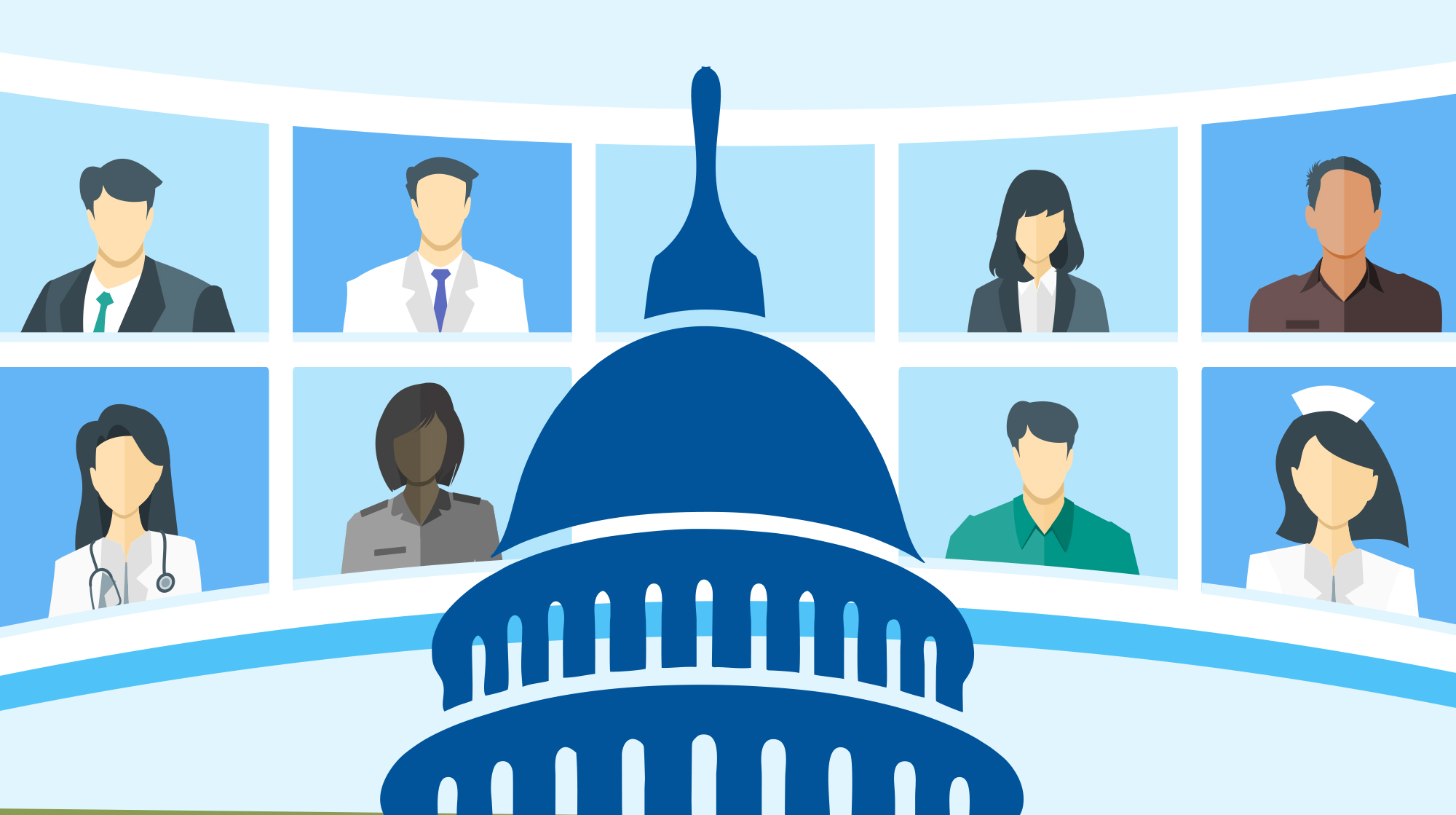Career resources content posted on NEJM CareerCenter is produced by freelance health care writers as an advertising service of NEJM Group, a division of the Massachusetts Medical Society and should not be construed as coming from, or representing the views of, the New England Journal of Medicine, NEJM Group, or the Massachusetts Medical Society
Physician careers in public-service practice include clearly defined, mission-driven direct patient care, research, and administration. A myriad of opportunities abound on the local, state, national, and international levels and include serving transcultural and underserved populations. Inclusive training, self-advancement programs, and an extremely collegial work environment are more often the rule rather than the exception. Despite job security and good benefits, challenges unique to the governmental or regulatory setting include less remuneration and a work environment that is steeped in protocol, high visibility, and a complex bureaucracy.
— John A. Fromson, MD*
Opportunities are plentiful and varied for physicians who want to practice in the public-service sector. Government positions — whether in the clinical practice, research, leadership, or public policy realm — are available in a broad range of specialties and settings, in the United States and abroad. Physicians who work in the government sector cite numerous benefits, from intellectual stimulation and robust resources, to collegiality and a strong sense of mission.
By Bonnie Darves
Physicians who practice in government positions may work in broadly diverse settings and gain exposure to a wide range of clinical, research, and public health pursuits — from tracking infectious disease outbreaks here and across the globe, to evaluating new drugs, to implementing vital public policy, or improving the health of vulnerable populations.
Thousands of U.S. physicians work in federal or state positions, and at any given time, there might be hundreds of jobs available in the myriad agencies that employ physicians in clinical, administrative, or research posts (see Resources).
Some physicians in the private sector might have the impression that working in a government position, whether it’s clinical or administrative, would not be particularly exciting and could be inordinately bureaucracy intensive. That’s not what government-employed physicians report, however. These physicians cite many upsides, such as the opportunity to working alongside the best and the brightest in their fields and the excitement of being on the cutting edge of clinical research, policy development, or public-health initiatives with national or even global reach.
Consider, for example, some of the recent challenges that Tara Palmore, MD, has pursued. In 2012, the hospital epidemiologist and infectious disease specialist, who works at the National Institutes of Health Clinical Center in Bethesda, Maryland, found herself literally running ahead of a deadly bacterial infection — a “superbug” in research-center vernacular — that had killed several patients and continued to reach others despite the center’s strict controls. Working aggressively with a genome researcher colleague, Julie Segre, MD, the pair used the bacterium’s DNA to determine where and how it traveled and then isolated affected patients to eventually contain transmission.
That crisis isn’t representative of a typical week in Dr. Palmore’s life, but she does practice in a generally high-stakes environment every day. “Our patients are highly immunocompromised, so when there is transmission of any hospital infection here, there is often a sense of urgency,” said Dr. Palmore, who went to the National Institutes of Health (NIH) for a fellowship in 2001 and never left. “And in hospital epidemiology, no detail is too small. It’s very stimulating.”
In a more typical day Dr. Palmore divides her time between seeing patients on the infectious disease (ID) consult service, meeting with the ID team, and working with participants in the ID fellowship program, which she directs. As one of the 200 physicians in the 240-bed Clinical Center — the NIH employs a total of 1,300 — Dr. Palmore especially enjoys the collaborative nature of her practice, as she works alongside physicians in multiple specialties, scientists, and other health professionals. “On rounds on the patient care units, there are many, many consultants and research nurses — and that brings richness to the cases,” she said, “even though it’s not a big hospital.” Despite its size, the center employs physicians in nearly every specialty because of its somewhat unique population.
The appeal of the NIH for Nehal N. Mehta, MD, FAHA, is twofold: The ability to work in a broad variety of roles, from cutting-edge research to direct patient care, and to combine these roles to advance medical care generally. As chief of the National Heart, Lung and Blood Institute’s section of inflammation and cardiometabolic diseases, Dr. Mehta has found, in his view, the perfect job. “The attraction of the NIH position was that it gives me the ability to quench my academic, clinical, and research thirst in one job. There aren’t many places you can do that,” said Dr. Mehta, who is board certified in nuclear and preventive cardiology, and is the Lasker Clinical Research Scholar at NIH. He formerly worked at the University of Pennsylvania, where he still maintains a small practice in psoriasis.
In his current work, Dr. Mehta focuses on the role of innate immunity and inflammation in the development of cardiovascular and metabolic diseases. He also employs a transdisciplinary approach that involves genetic epidemiology, translational medicine, and novel cardiovascular imaging. Besides the excitement of breaking new ground, Dr. Mehta enjoys the flexibility his position affords. “You get to choose your pace here, and everything is done pretty much at the discretion of the PI [principal investigator]. There are many training and self-advancement opportunities here, and the resources are surprisingly plentiful — and comparable to academia,” he said.
Mission calls many government physicians
Capt. Stephen “Miles” Rudd, MD, FAAFP, works in a somewhat quieter setting, albeit on a larger population scale, than Dr. Palmore does. As the chief medical officer and deputy director of the Portland (Oregon) Area Indian Health Service (IHS), Dr. Rudd is reminded daily of the mission he chose — to serve vulnerable individuals. “I joined the IHS because I wanted adventure, but primarily because I knew that I wanted to work with an underserved population,” he said. The IHS offers that combination, in spades, in addition to broadly diverse responsibilities, according to Dr. Rudd, a family physician who now chairs the IHS National Pharmacy & Therapeutics Committee.
On the Warm Springs Reservation in Madras, Oregon, where he spent 14 years, Dr. Rudd delivered babies, cared for patients across the lifespan in the clinic, hospital, and nursing-home settings, and served as medical examiner. Along the way, he developed expertise in tuberculosis, helped implement model diabetes care, oversaw initial implementation of the IHS electronic health record, and was pivotal in getting a seat-belt law passed on the reservation — an achievement of which he is especially proud. “It was gratifying to know that we could affect the health of an entire population, because accidental death was the leading cause of death on the reservation before the law passed,” he said.
For many physicians who work in government positions, it’s the mission that attracts them and keeps them there, Dr. Rudd observes. “What impresses me about the people who work in Indian Health is what we can do as committed individuals — there’s a sense of mission that drives us, I think, and that’s what I find most gratifying,” he said. “And we’re actually delivering cutting-edge care in many ways. I think that would surprise some physicians.” The IHS employs physicians in more than a dozen specialties, and in settings ranging from remote reservations to inner-city health facilities.
In joining the Health Resources and Services Administration (HRSA) four years ago, Seiji Hayasji, MD, MPH, FAAFP, broadened both his professional career in public health and his personal desire to improve access to high-quality health care for vulnerable individuals. Now acting director of the Division for Medicine and Dentistry in the Bureau of Health Professions, Dr. Hayasji oversees the vast network of federally qualified health centers (FQHCs) that serve more than 21 million Americans — at an important juncture in history, when legislation has mandated expansion of that safety net.
“I oversee clinical quality strategy — to essentially determine whether the providers are in the right place, and whether the care is high quality and meets patients’ needs,” said Dr. Hayasji, who previously worked as a researcher and professor of medicine at George Washington University. “My main job is to ensure that the policies are in line with the care provided, which means that I must spend some time practicing.” He has cared for patients at a Washington, D.C., FQHC for more than a decade.
Dr. Hayasji, who was asked to join HRSA, was honored by the request. Still, he admits that it was a tough decision to leave the university. “This is a pretty visible job, and it involves a lot of PR. It’s very different than academia, where you publish what you want,” he explained. “There is no such thing as ‘I’ in the federal government. It was challenging at first, and I made my mistakes because I have my opinions — and I needed to remove myself from that perspective. I am fine with that now, and what is exciting, every day, is being able to impact the lives of so many patients.”
Like Dr. Hayasji, pediatrician David Willis, MD, FAAP, was recently tapped by HRSA to direct a vital government program created by the Affordable Care Act — the Division of Home Visiting and Early Childhood Systems in the Maternal Child Health Bureau. He, too, feels called by the mission, in this case to act nationally on the evidence that underscores the value of early childhood health and educational interventions.
“It was an unexpected solicitation, and it’s an incredible opportunity to expand the federal government’s home-visiting programs across the country, at an amazing time,” said Dr. Willis, who helped two Oregon governors craft early childhood legislation and most recently participated in the Harvard Center for the Developing Child’s Frontiers for Innovation program. Dr. Willis acknowledges that he spends a lot of time in meetings, and expends considerable effort “telling the story” of home visiting’s importance. “It’s as exciting as clinical medicine, but the excitement here is the opportunity to work with a much larger population and to influence change,” he said, noting that several states are seeking qualified physicians to help implement the national program.
Collegiality, commitment ‘pleasant’ surprises
When asked to describe their colleagues in government, both Dr. Willis and Dr. Hayasji shared a view echoed by several sources interviewed for this article: Many bright, creative physicians and health professionals work in government positions, and are highly committed to the work they do and the population they serve. This makes for both a gratifying and intellectually stimulating environment. “There are many brilliant and dedicated people in the federal government—and I work in a setting where a lot of innovation is occurring,” Dr. Willis said.
That same realization came as a pleasant surprise to Richard Moscicki, MD, a newcomer to the government sector who serves a deputy center director for science operations at the U.S. Food and Drug Administration’s Center for Drug Evaluation and Research (CDER). “What I have found at CDER, especially in leadership, is that these are very bright people who would succeed in any setting,” said Dr. Moscicki, who formerly worked in clinical development at Genzyme Corporation, and thus, he notes, “across the table” from the FDA. “There is a culture of empowerment and intense intellectual debate here that surprised me somewhat — it’s a very creative environment, not a monolith, where you have the opportunity to see the very best of science.”
Speaking of talent and collegiality, Dr. Moscicki is quick to point out that CDER is on the cusp of major change in the areas of both new drug development and generic drug evaluation, and is in a major hiring mode as well. In addition to the drug-reviewer positions that become available periodically, CDER is looking for physicians to fill executive-level positions in the areas of new and generic drugs, medical policy, and compliance, for example. “We also are expanding how we look at risk/benefit and how we define risk and enter it into the [evaluation] equation. And there are exciting roles for physicians in these areas,” Dr. Moscicki said. Physicians account for approximately 10 percent of all jobs within CDER, not including those affiliated with the U.S. Public Health Service within the FDA.
Practice settings can span the globe
Most physicians in government positions practice or work within the United States, but some operate from far-flung places at times. For example, consider the career path of Jeremy Sobel, MD, MPH, a medical epidemiologist and preventive medicine specialist at the Centers for Disease Control and Prevention (CDC) in Atlanta. He recently returned from Brazil, where he advised participants in the Brazilian Ministry of Health’s two-year Field Epidemiology Training Program (FETP). The CDC helps FETPs in countries throughout the world build capacity for detecting and responding to health threats and develop expertise to detect and contain disease outbreaks.
While in Brazil, Dr. Sobel traveled with trainees to remote regions of the Amazon River only reachable by boat, to study the rare and life-threatening bacterial infection Brazilian Purpuric Fever. “Our trainees investigated potential sources of purpuric fever and organized the distribution of antibiotics,” Dr. Sobel said. “This is one example of how properly supervised and deployable professionals can work in real time to prevent an outbreak.” In another initiative, Dr. Sobel and his trainees helped the government launch a major national campaign to increase vaccination rates for rubella.
Earlier in his career, Dr. Sobel’s work took him to New York City, where he worked in sexually transmitted disease prevention. He also has developed considerable expertise in enteric illnesses and diseases, and frequently makes presentations in this area. “I enjoy the opportunity the CDC gives me to work in vastly different locations — including places where the tourists never go,” he said. “I also appreciate the fact that the work I do affects many people, often at the level of prevention and control. I help prevent those cases you never get to count. And what’s also exciting is knowing that the CDC serves as a reference laboratory to the world.”
One of Dr. Sobel’s colleagues, Seymour Williams, MD, MPH, also has vast experience working in remote regions. Since joining the CDC he has investigated avian influenza in Hong Kong and rubella in the Caribbean, worked on HIV/AIDS care and treatment in Ethiopia, and closer to home, investigated childhood asthma in Atlanta. He currently is in South Africa, serving as a resident advisor in the Field Epidemiology Laboratory Training Program.
Dr. Williams and Dr. Sobel are both U.S. Public Health Service Commissioned Corps (PHSCC) Officers. PHSCC is the federal uniformed service of the U.S. Public Health Service (PHS) and is one of the seven uniformed services of the United States. Dr. Williams chose his current position because of the opportunity it affords, he observed, “to fulfill the very important public health need in emerging countries, of training competent public health professionals. “This position is not clinical,” Dr. Williams noted, “but my clinical skill and experience is called on continuously as I supervise the residents when they are involved in public health investigations.”
In his current posting, for example, he has worked with the residents in outbreaks of antibiotic-resistant bacteria, food and waterborne diarrhea, and vector-borne illnesses such as Crimean Congo hemorrhagic fever. Besides the geographic variety the work affords, he appreciates the teaching role he performs. “During outbreak investigations, trainees go through this epiphany of sorts as they collect the patient data, review the environment, and … synthesize hypotheses of what caused the outbreak and what can be done to mitigate it,” he explained. “Seeing this process continues to motivate me.”
Certain challenges must be navigated
The physicians who shared their perspectives for this article concurred that government work, however gratifying, does have its downsides. From a practical standpoint, government positions typically pay less than clinical or administrative positions in the private or academic sector — even though they offer security, good benefits, and in some cases, education loan repayment.
The other challenge several sources cited is the bureaucracy that sometimes attends the public service or regulatory environment; none, however deemed that intrusive enough to deter enjoyment of the work. Finally, physicians who move into the government realm from positions in either industry or academia might find the transition rocky initially, and the learning curve steep.
“There are minor irritations of bureaucracy, but I think that you find that anywhere,” Dr. Moscicki said. He added that one upside of working at CDER — exposure to broadly diverse viewpoints — is also a challenge at times. “We must come to consensus to make a decision that we then offer to the world,” Dr. Moscicki explained. “There is a different thought process that’s important in acting as a regulatory authority, and that is deeply based on knowledge of the law and on precedent.”
Dr. Mehta echoes Dr. Moscicki’s view on the bureaucracy and occasional constraints inherent in government positions. “Everything has a standard operating procedure here. One of my current studies, for example, has 29,” he said. “You also have to be extremely mindful of protocol, and remember that the federal government is not only highly regulated but also highly visible. That can take some adjustment. At the same time, you realize that if you were in human-based research, you realize that you would appreciate all of those standard operating procedures!”
Resources
The federal government’s website, USA JOBS, www.usajobs.gov, includes hundreds of physician positions, in areas ranging from clinical care to administration, and research to policy development. The individual agencies also post open positions on their web sites.
*Dr, Fromson serves as the editor for Career Resources and is Vice Chair for Community Psychiatry, Brigham and Women’s Hospital; Chief of Psychiatry, Brigham and Women’s Faulkner Hospital; Associate Professor of Psychiatry, Harvard Medical School.







